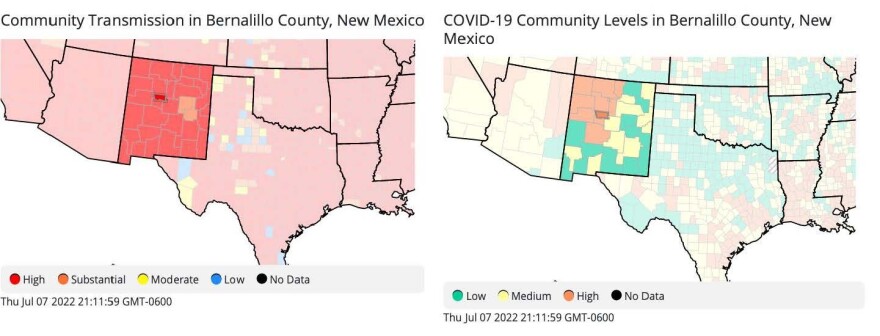New Mexicans face fresh challenges calculating COVID-19 risk due to lagging attention to surveillance and steps like masking and social distancing to stop the spread. New Mexico has eight times the daily case average and nearly three times as many hospitalized with COVID-19 compared to last July. A mask mandate is not being considered by state officials.
An understaffed Department of Health provided its last media COVID-19 briefing on June 8th. Since then, 100 more New Mexicans have died from the disease, over 2,000 since January. By comparison, DOH shows almost 200 pneumonia and flu deaths combined from October, 2021 to May 15, 2022. Since the year’s start 23 New Mexicans lost their lives to gun violence.
As of July 8, eleven counties were red or high community level, including the six of the seven most populous counties in New Mexico like Bernalillo and Santa Fe. Most of neighboring Arizona is medium or high level and all counties around the Four Corners are red. The CDC says high community levels indicate all people gathering indoors should wear an N95 or equivalent mask. High community levels indicate dangerous numbers of infections by county and hospitalizations and inpatient beds usage in the Health Service Area. Under CDC guidance used before February 25, 2022, called Community Transmission, a measure of pure case rate and test positivity, all but two New Mexican counties are at the highest transmission rates. The whole of the state is red by the old guidance, as the image above shows.
According to DOH, one out of three New Mexicans are at high risk for severe illness from COVID-19 and their community should take additional precautions. One out of five of those with COVID-19 may develop Long COVID symptoms, making them “at risk” for severe illness from future infections.
For the public, calculating risk is complicated because DOH estimates that for every confirmed test, there's up to seven additional people with active infections. Some national estimates are as high as 30 additional people.
According to the DOH dashboard, on July 9, 2021, 77 New Mexicans were in the hospital with COVID-19 and the daily case average was below 100. On July 8, 2022, there were 1252 new cases, 168 people were in the hospital (15 of them ventilated) and the 7-day average daily case number is nearly nine times higher, according to the New York Times. Since July 2021, the number of deaths in to COVID-19 in NM doubled from about 4,000 to nearly 8,000.
While treatment and prevention regimens now exist, including vaccinations for all New Mexicans over 6 months of age, advocates have criticized the most recent rollout. Janeth Nuñez del Prado, representative of Marked By Covid in New Mexico, and a parent of a 2-year-old, was frustrated in the week after the DOH announcement.
"What I see as a failure and something that has been very harmful to my community is the vaccine rollouts for kids birth to four. This was a landmark development for parents like me who've been navigating this pandemic for over two years with little to no protection against COVID. I have a 2-year-old and with mask mandates being lifted in schools and daycares, he was left very defenseless."
She continued, "I have seen no media announcements from the Department of Health or any campaigns to educate the public that vaccines are now available for young children and have been demonstrated to be safe and effective. Where are the billboards announcing that the vaccine is here? Many of our group members found out through me. I spent the weekend trying to help them find appointments at various pharmacies for their children. People were scrambling. I couldn't even get into my pediatricians office to see if they had vaccine appointments because the lines were flooded; because we were given no information."
DOH declined to respond to the criticism. The last DOH update on the vaccination effort was June 21st. It did have one Facebook post about the expanded vaccine eligibility. But until 3pm on July 8, its Facebook Page sported a banner from last November that doesn’t include that information—now it reflects a new campaign for all childhood immunizations without specifying COVID-19. Historically, vaccination campaigns are a primary success story of public health.
"It should not be left to the community's most harmed by the pandemic to provide people with access to this information," said Nuñez del Prado. "It was chaotic and confusing and the most recent example of how the New Mexico Department of Health seems to have bought into the narrative that COVID is over and is no longer a concern. Or that it's somehow acceptable for young children to be exposed to COVID with no protection. The lack of public health messaging was a resounding message. They are no longer prioritizing, educating the public on the importance of getting vaccinated or enacting policies to protect our citizens from being exposed to this potentially deadly and debilitating disease."
DOH is understaffed: Of 338 total positions in the Epidemiology Division, 94 are currently vacant, including the State Epidemiologist, which “directs the Epidemiology and Response Division and serves as the Chief Epidemiologist for New Mexico Department of Health and the State of New Mexico.” Dr. Christine Ross leaves July 10. Another link to the public, the Health Equity Communications Manager left in June.
No replacements have been named, but According to David Morgan, spokesman for the NMDOH Office of the secretary, “The Department of Health continues a national search for the position formerly held by Dr. Christine Ross. Deputy Secretary Dr. Laura Parajón serves as director for the Epidemiology and Response Bureau in the interim. The Health Equity Communications Manager position is currently open, and the agency is accepting applications.”
Dr. Parajón also covers for Dr. Scrase, who is leading DOH and the Human Services Department, when he is unavailable.
This is an updated list of resources for those impacted by COVID-19.












